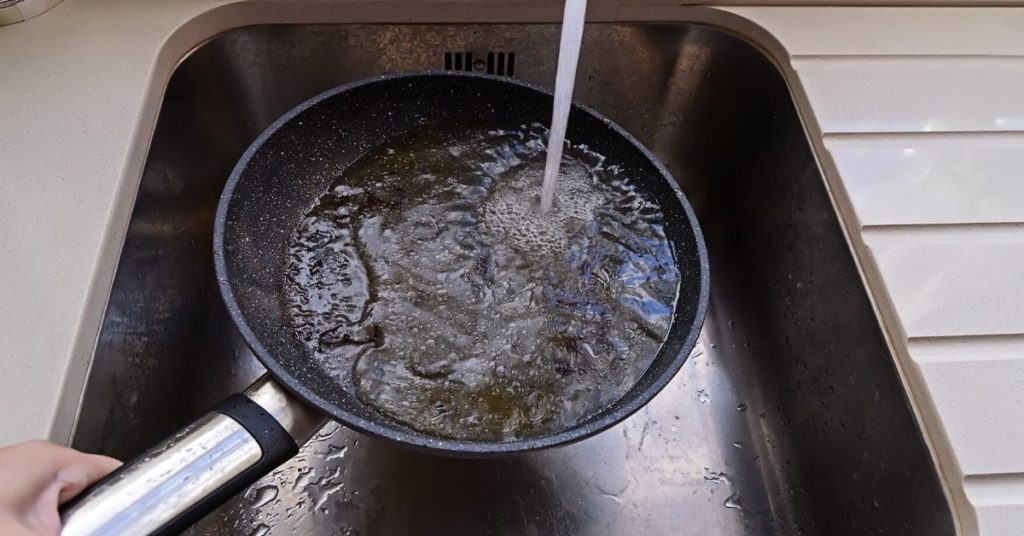Publicly owned treatment works (POTW) often struggle to limit fats, oils, and grease (FOG) intake in their wastewater systems. Excess FOG buildups can prevent wastewater flows causing blockages in collection lines. Additionally, heavy FOG discharge can disrupt treatment at wastewater plants.
To achieve an effective pretreatment plan, POTW can begin by understanding how FOG enters their systems. The following list identifies 7 noticeable ways FOG are introduced into wastewater collection systems.
1. Household
FOG become domestic wastewater when residents dump cooking grease down the kitchen sink or other household drains. For many individuals, disposing of cooking fats in this way is mundane; Their parents always dumped grease down the sink, so why shouldn’t they? Misinformation about disposing of fats, oils and grease has been passed down through generations and contributes to domestic grease loadings.
Individuals are often uneducated on the impacts of grease in POTW wastewater systems. High strength domestic wastewater can contain 25 to 14,958 mg/L of FOG. Fatty organic loadings of this magnitude contributes to collection line blockages and POTW wastewater processing upsets.
2. Restaurants
High strength wastewater inputs from restaurants often contributes to POTW FOG issues. Fatty organic substances are introduced into collection lines due to poorly maintained grease interceptors and inadequate management practices. The EPA-833-F-12-003 (2012) states, “grease trap waste and uncollected grease entering sewage treatment plants can be significant and ranges from 800 to 17,000 pounds/year per restaurant. Additionally, FOG can enter POTW through floor drains, mop sinks, floor sinks, and trough/trench drains.
Lack of understanding and education on proper cooking oil management perpetuates FOG related problems for POTW. Uninformed restaurant staff can contribute to SSO, CSO and NPDES permit violations. Lastly, restaurants should understand that receiving wastewater services from local POTW is a privilege not a right. This privilege can be terminated if proper FOG handling is not maintained.
3. Car Washes
Car and truck washes can contribute to POTW FOG loadings. Because of high FOG concentrations in car wash discharge, this wastewater may require special treatment to remove fatty organic materials. Although this source of FOG may be less consistent than household and restaurants, POTW may want to consider car washes when monitoring all FOG sources.
4. State Health Regulations for Dishwashing
Restaurants are required to abide by state health codes to stay in business. Dishwashing water temperature requirements vary by state but range between 140-165℉. Temperature regulations for washing dishes and floors cause restaurants to liquify grease. Consequentially, restaurant FOG is washed down drains and into local collection systems.
5. Faulty Pretreatment
To establish an effective pretreatment plan for FOG, POTW need to check their systems correctly. Failure to collect and analyze wastewater data can cause municipalities to misdiagnose fatty organic loadings. In addition, miscalculating the maximum acceptable headworks loading (MAHL) for FOG (per individual POTW) can impact how effective a local limit (or ordinance) will be. Lastly, pretreatment programs that are poorly integrated into local businesses can be misunderstood. Providing resources and time for businesses comply with pretreatment regulations is highly important for the plan’s success in the community.
6. Local Regulations Not Enforced
Some POTW have grease ordinances in place but they are not strongly enforced. Establishing a penalty system for businesses that violate local limits is essential to prevent FOG from getting into collection systems. In addition, conflicting personal interests and local politics can impact grease ordinance enforcement. Local governments have been accused of unfairly administering violation fines. Accusations were made, because the individual enforcing the grease ordinance did not fine his own business but fined others he was not financially attached to. An equal and consistent form of enforcement can limit FOG pretreatment plans from benefiting POTW.
7. Food Manufacturing Industries
Industrial food processing usually contains wastewater with high concentrations of organic solids and FOG. Therefore, FOG discharge in food manufacture wastewater can overwhelm POTW and collection infrastructures. POTW capacity for fatty organic substances is typically much less than what vegetable processing, dairy, and slaughterhouse effluents contain. Unregulated food manufacturing plants (especially in rural locations) can contribute greatly to FOG buildups and treatment plant inefficiencies in POTW.
Conclusion
The primary sources of FOG that can be regulated by POTW grease ordinances are restaurants, car washes, and food manufacturing industries. To address the additional items on the list, changes in regulation and individual understanding of FOG management are required.
POTW that establish and enforce their pretreatment plans will better mitigate FOG related issues and federal regulation violations. Establishing equality in all aspects of implementing and enforcing the plan will promote better community compliance with new regulations. Lastly, educating residents and food service employees on proper FOG disposal is essential to reducing grease inputs.


